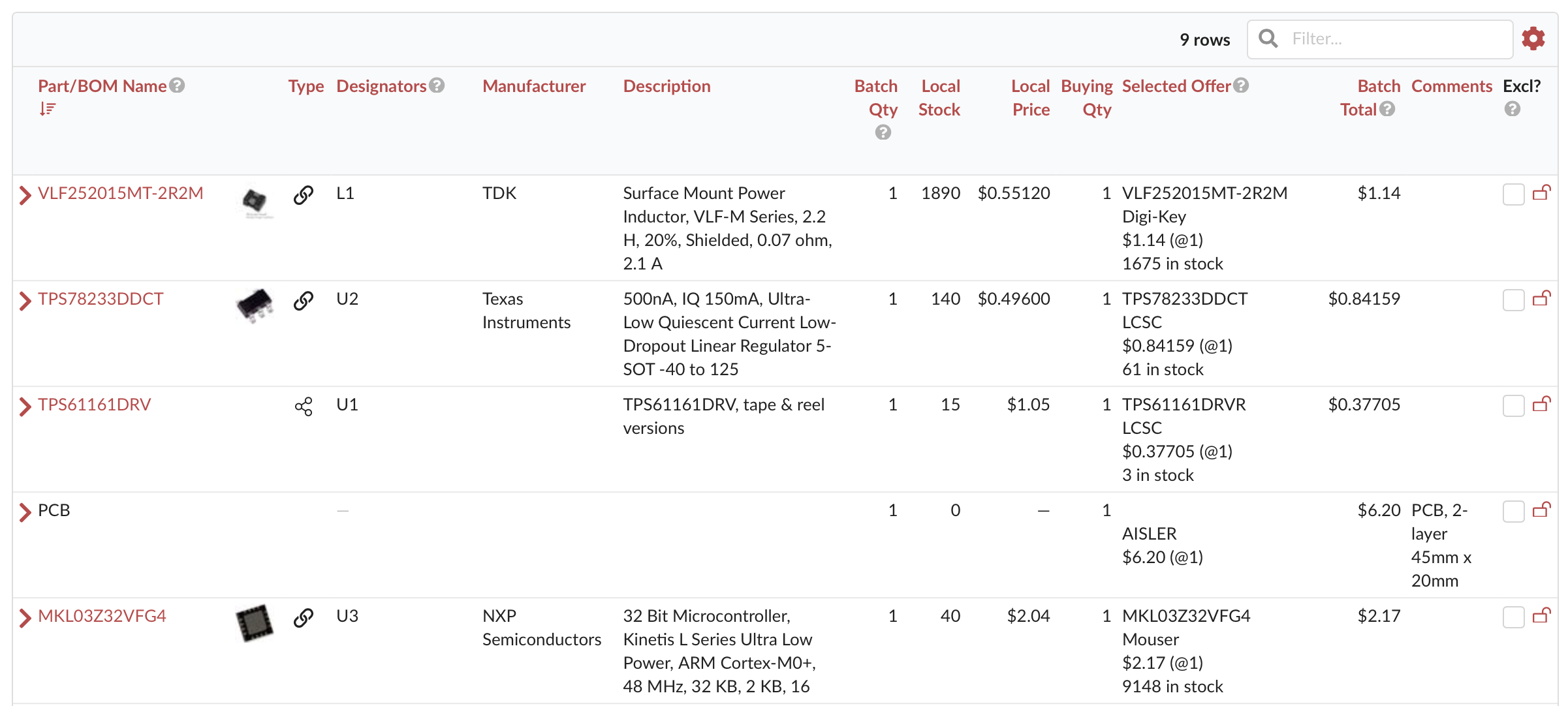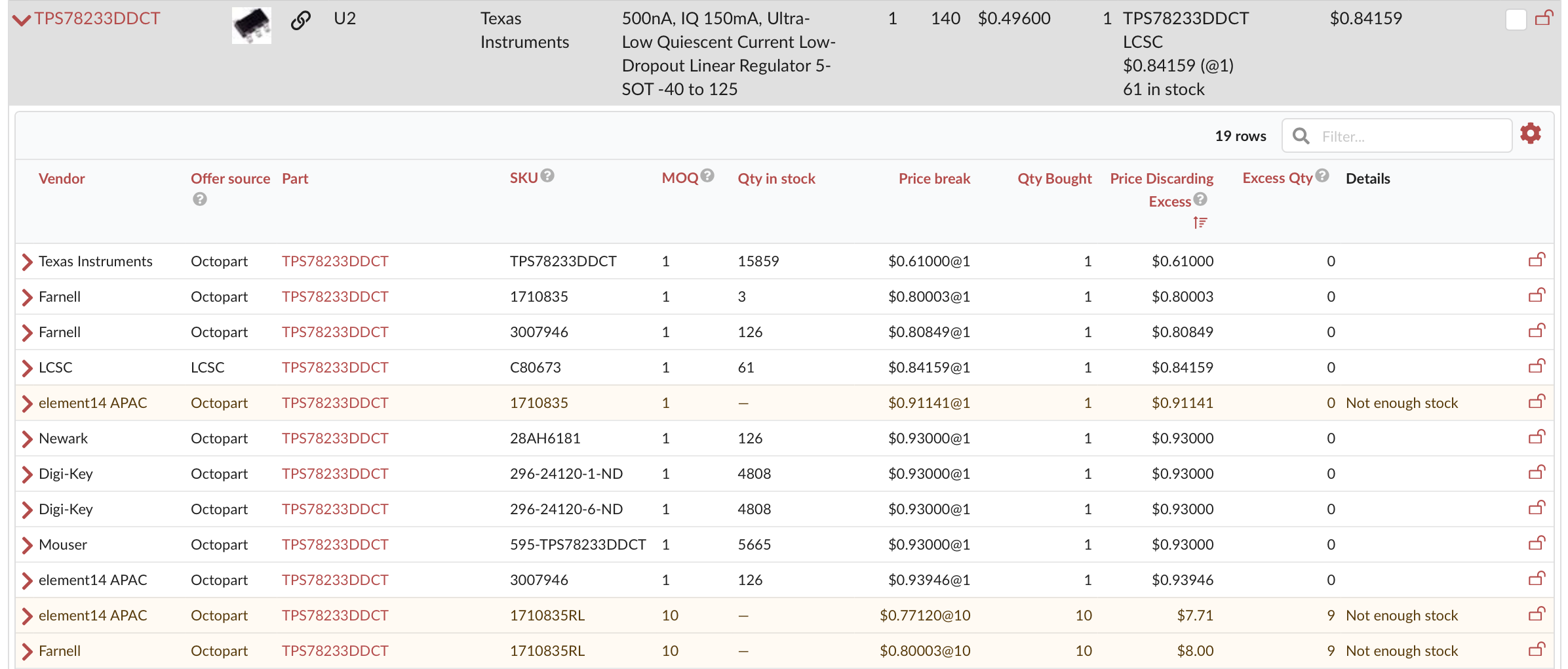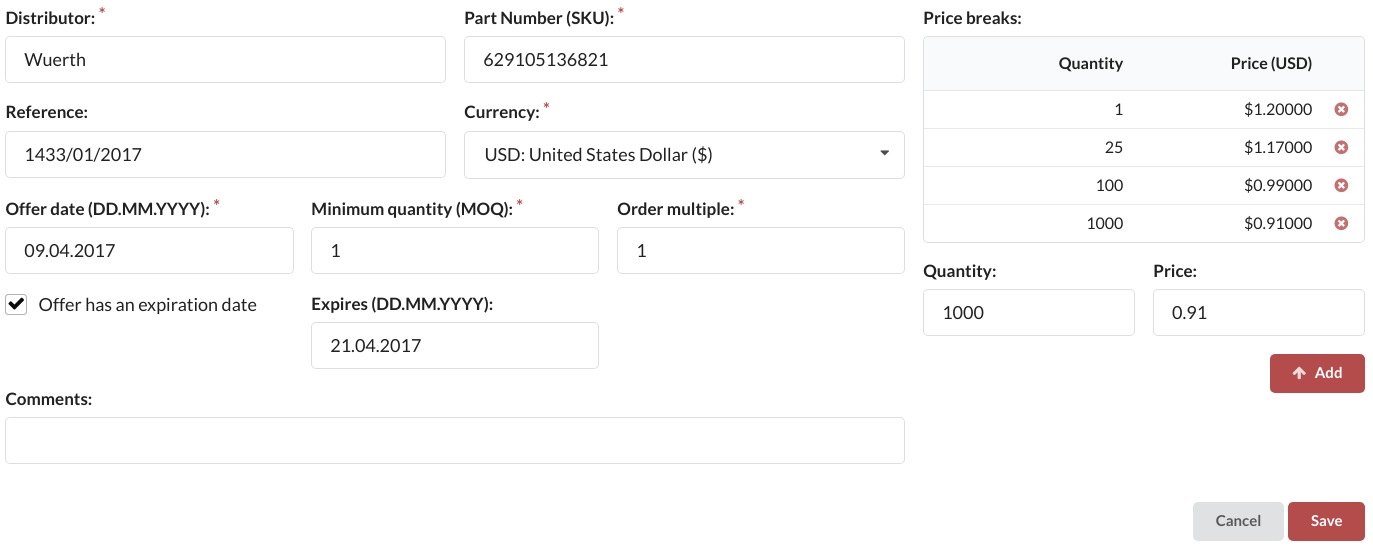BOM Pricing
Why using a BOM spreadsheet is not a good idea
Many people rely on spreadsheets to organize their Bill of Materials (BOM) and calculate associated costs. These spreadsheets typically feature columns for various data points such as manufacturer part numbers, distributor part numbers (also known as Stock Keeping Units or SKUs), quantities, and prices. The process involves searching for component parts, comparing distributor prices from a few suppliers, and then selecting and entering the most favorable price into the spreadsheet.
However, this method has significant limitations, particularly regarding its scalability. Even for relatively small projects involving 20 to 40 components, the task of researching prices and updating the spreadsheet can be quite a lot of work.
The other issue is that spreadsheets were designed for simple tabular data. But distributor offers are anything but simple! For instance, distributors may use varying price break structures, making direct comparisons difficult. While one supplier may offer price breaks at quantities of 100, 500, and 1000 units, another might do so at 25, 250, and 500 units. Additionally, there are logistical considerations such as Minimum Order Quantities (MOQ) and order multiples that further complicate comparisons.
On top of that, dealing with multiple currencies presents another layer of complexity, particularly for companies operating in Europe that might transact in EUR, USD, and possibly a third local currency. This aspect often introduces challenges in terms of currency conversion and financial management.
Maintaining a Bill of Materials using spreadsheets can quickly become a cumbersome and time-consuming task. Such spreadsheets can grow large and unwieldy, demanding considerable effort to keep updated. This often results in BOMs that become outdated shortly after their creation. Furthermore, the issue of selecting between multiple equivalent parts—also known as alternates—adds another dimension of complexity to managing BOMs through spreadsheets.
Projects/BOMs
In PartsBox, a Bill of Materials (BOM) is referred to as a Project. This Project encompasses a list of parts, with certain parts connected to online identities, known as Manufacturer Part Numbers (MPNs), while others are generated internally. Upon navigating to the Pricing tab within a project, PartsBox actively retrieves the most current pricing information and showcases your BOM, complete with detailed sourcing information. This means that your BOM is never out of date.
Online offers
For every BOM entry that is linked to an online identity (Manufacturer Part Number), PartsBox gathers online offers, and selects the best (least expensive) one. There are often as many as 20-40 offers for any given part. In the main BOM pricing table, only the best offer is displayed.

For meta-parts (generic parts that group several alternate parts that are interchangeable), offers for all member parts will be gathered together and compared.
For every part, the quantity required will be adjusted based on part attrition parameters.
Price breaks and offer selection
The selection process is quite involved, as it has to handle:
- price breaks, which can be different for every offer,
- availability and stock information,
- Minimum Order Quantities (MOQs),
- order multiples,
- multiple currencies.
PartsBox normally selects the best offer based on 'Price Discarding Excess'. That is the price paid for parts, assuming that any excess inventory that has been purchased will be thrown away. Why not just use the price from price breaks? Well, in case of restrictions such as MOQ or order-multiple, we do not want to discard offers just because the quantity we need is too small. It is sometimes better to buy more, because of price breaks: the price might be competitive even assuming we will discard anything we don't need. This is why quantities are rounded to order multiple, and if the quantity is below MOQ, PartsBox will round it up to MOQ, just to see how the offer ranks.

The ranking of offers changes based on your build quantity, and so does the best offer. One can often discover new, unexpected sources of parts that become attractive at certain quantities. As an example, not everybody knows that Texas Instruments sells directly and is very price-competitive at quantities above 500.
Every offer can be unrolled to show details like packaging, quantity on order, on order estimated time of arrival (ETA), factory lead time and factory order multiple.

It is possible to 'lock' a particular offer by using the padlock icon. This locks the offer selection for this project entry, and that particular offer will be used to calculate BOM price.
Local offers
While some components are bought from major distributors, one often deals with other suppliers, or gets custom offers for specific quantities, with discounts. This is why PartsBox allows for entering your own offers, which are then considered and ranked together with online offers.
A local offer can be added either from within a project, or directly to a part. Like every offer, it can have multiple price breaks at any quantities, as well as a minimum quantity (MOQ) and order multiple. These parameters will be used by the pricing algorithm.

Apart from additional info fields like order reference/number, date or comments, an expiration date can also be entered. An offer will not be considered if it has expired.
Any offer can use any of the supported currencies.
Local stock
For a new project one needs to purchase all the parts. But more often the situation is different: local stock is already present, purchased at a certain price. PartsBox handles this transparently.
When pricing a project, one can choose how parts are sourced. Three options are available:
- Only use local stock: this will only consider parts that you have in stock already.
- Only buy new components: this will ignore local stock and only consider the buying scenario.
- Use local stock, then buy if needed: this will use local stock, and if it isn't enough, consider buying.
In all scenarios pricing will be correctly calculated, possibly using a mix of parts from various sources.
Currency handling
PartsBox takes care of multiple currencies for you. Just select your preferred currency in the settings, and it will be used to display every price. You can change the currency at any time.
European Central Bank (ECB) rates are used for currency conversion. The rates are updated regularly.
For offers which you entered yourself, you can pick any supported currency, and it will be handled correctly.
Offer filtering and what-if scenarios
It's easy to consider various buying scenarios:
- The list of distributors from around the world can be narrowed down to your preferred distributors that you actually buy from.
- Distributors can be filtered to exclude non-authorized ones.
- For theoretical pricing estimates, one can also include offers where distributors have no stock.
Project/BOM pricing in PartsBox
PartsBox project/BOM pricing solves many problems encountered every day when dealing with electronics production, offering significant benefits to design houses, Electronic Manufacturing Services (EMS) companies, and anyone requiring current pricing information for electronic BOMs.
Although simple spreadsheets, BOM Calculator, or BOM Tool pages might provide initial pricing estimates, PartsBox helps with efficient pricing management over extended periods without requiring substantial effort. This efficiency is important in the electronics industry, where timely and accurate cost estimation directly impacts decision-making, budgeting, and profitability. By automating the collection and comparison of pricing data, PartsBox helps with the procurement process, ensuring users can maintain up-to-date and competitive pricing for their projects with minimal manual intervention.